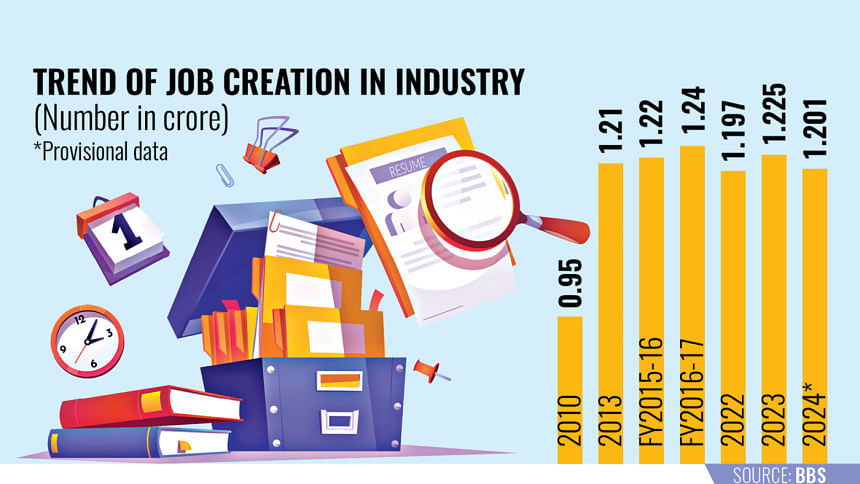Industrial output soars, but where are the jobs?

Over the past decade, more and more industries have sprung up across the country, steadily increasing production. But while output rose, factories did not open their doors to more workers.
Between 2013 and 2024, this disconnect played out clearly. Economists describe it as a case of the "jobless growth" puzzle.
In 2025, industry accounted for 34.81 percent of Bangladesh's gross domestic product (GDP), up from 27.55 percent in fiscal year (FY) 2009-10. Factory output expanded by 10 to 20 percent over the years.
Yet, the number of workers in production units fell — from 1.21 crore in 2013 to 1.20 crore in 2024.
Economists say the driving force behind this industrial growth was large-scale factories equipped with modern and automated technologies. These production lines needed fewer hands on deck.
Some of these high-performing industries, though employing relatively few workers, produced more value-added goods. That, in turn, meant a bigger share of GDP without creating more jobs.
Other factors also contributed, but experts warn that unless the country invests in workforce training, technology upgrades, and better planning, it risks missing out on the employment benefits that usually come with industrial growth.
"The declining trend in manufacturing jobs runs counter to expectations," said Rizwanul Islam, former special adviser at the International Labour Organization's (ILO) Geneva office. "This is a reversal in the structural transformation of employment."
He said that instead of a rising share of manufacturing jobs, there has been a fall, even as agricultural employment has increased.
Islam said this trend is disappointing because it is occurring despite growth in industrial output and exports. "It reflects a situation of jobless growth."
KAS Murshid, former director general of the Bangladesh Institute of Development Studies (BIDS), echoed similar views.
He said industrial growth is occurring, but labour demand is not keeping up.
According to him, jobs are rising in services, non-farm rural activities, and the informal economy, yet formal industry remains a barrier.
Murshid, who led the interim government's taskforce on Economic Strategy Redesign, said the problem lies partly with automation and partly with the mismatch between labour demand and supply.
"You cannot create employment just by having a large population anymore. Unskilled labour is not in demand like before. We need semi-skilled, skilled, and technically trained people, and that is where we are falling short," he said.
The former BIDS DG said there is a severe shortage of skilled labour in the country. "We have found it in BIDS research and other studies. Although there are some projects funded by lenders and run by the government, they are not enough. Much more needs to be done.
"If we look at emerging economies worldwide, including Bangladesh, the direction is clearly toward AI-driven technology. And we are simply not ready for that."
Asked about the consequences of this "jobless growth", Murshid said, "If we want to move forward, we need policies that strengthen the supply side. Our core focus has to be on building a skilled labour force.
"The gap is not just in schools or colleges; we must incentivise industries to fund large-scale training and prioritise quality over quantity in skilled manpower."
He said this growing skills gap needs a multi-pronged and well-coordinated strategy. "It is not something we can fix by piecemeal efforts."
Khondaker Golam Moazzem, research director at local think tank Centre for Policy Dialogue (CPD), said that most industrial growth during the past decade came from large enterprises, not small or medium-sized ones.
"These large industries have developed their supply chains and adopted more technology-driven production systems, many of which are labour-displacing," said the industrial economist.
According to Moazzem, production has surged not because of more workers, but because productivity has increased.
For instance, he said Bangladesh is now exporting garments worth more than $40 billion with fewer workers than when the country exported just $10 billion.
"That means we have become more reliant on hi-tech machinery, and the skill levels have improved," said the economist. "We are also producing higher value-added items, which increases output without more workers."
In agriculture, he said, there has been little value addition. As a result, its share of GDP has fallen, though employment levels remain largely unchanged.
"By contrast, industry's share has grown, but employment has remained almost static."
"Much of the recent growth has not come from manufacturing alone. It is increasingly in service-linked areas like warehousing, transport, insurance, and supply chain services — sectors that tend to be less labour-intensive," he said.
"Our export structure has also become more concentrated in garments. It was 75 percent earlier, and now it is close to 85 percent. We have not seen diversification into other industries.
"So, while industrial GDP is rising, employment is not growing in parallel. Productivity and efficiency gains are real, but they have not yet translated into greater labour absorption," he added.
Labour economist Nazmul Hossain Avi sees this as an early sign of "de-industrialisation" and "economic divergence".
While automation and emerging technologies may be part of the story, he said the lack of a diverse manufacturing base is holding back job creation. The country is focusing only on the easiest options.
"Skills development and training," he said, "is where we must begin."
"Bangladesh needs to review and update the National Employment Policy (NEP) 2022, which was hastily made and weakly structured, merely aiming for a checkbox," Avi added.
"The NEP also needs a rigorous implementation plan that involves more ministries beyond the Ministry of Labour and Employment. Employment should not be the sole responsibility of one ministry; it involves many, if not all, government sectors.
"Unless we create more formal jobs in industries, the country will continue to face an increasing deficit in decent work."
Prof Abu Eusuf, executive director of local think tank Research and Policy Integration for Development (RAPID), highlighted another key issue, which is the mismatch between what academic institutions teach and what industries need.
"We are seeing skilled professionals from neighbouring countries filling key roles in our industries, roles that Bangladeshi graduates could have filled if academic institutions were aligned with real market demand," he said.
Recent factory closures and layoffs, both in Bangladesh and abroad, have made matters worse.
"Many workers are still struggling to recover their livelihoods, and the industrial job market remains fragile," he added.
He called for science and technology universities to focus on their original mission.
"Instead of producing general graduates, they should focus on market-relevant STEM degrees in engineering, statistics, and mathematics, aligned with current and future labour market demand."
On the ongoing high policy rates, Eusuf said, "The high policy interest rate may have been necessary to curb inflation, but it has also created inertia in private investment. That slowdown is directly impacting employment generation.
"Unless we see greater political stability and a reduction in the cost of doing business, private investment will not pick up. And without that, job creation will remain a major challenge," he added.
Meanwhile, former ILO adviser Islam pointed out the gendered impact of declining industrial jobs.
"Manufacturing has traditionally been a major source of employment for women. A decline in jobs in this sector does not bode well for them, especially as the proportion of women in the RMG industry has already been falling," he said.
"The service sector cannot serve as a substitute for manufacturing jobs. Many of the jobs in services are in low-productivity, low-income activities. These may help people survive, but they do not offer a sustainable path out of poverty," said Islam.

 For all latest news, follow The Daily Star's Google News channel.
For all latest news, follow The Daily Star's Google News channel. 





Comments